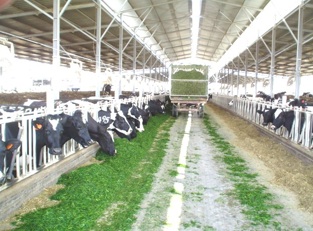
News
Greenhouse gas calculator developed for Canadian dairy industry
March 25, 2009 by Atlantic Dairy and Forage Institute
 March 23, 2009, Junction, NB – The Atlantic Dairy and Forage Institute
March 23, 2009, Junction, NB – The Atlantic Dairy and Forage Institute
(ADFI), in partnership with the Dairy Farmers of Canada (DFC), and
Agriculture and Agri-Food Canada (AAFC), is in the final stages of
developing a greenhouse gas quantification protocol and calculator
software for the Canadian dairy industry.
March 23, 2009, Junction, NB – The Atlantic Dairy and Forage Institute (ADFI), in partnership with the Dairy Farmers of Canada (DFC), and Agriculture and Agri-Food Canada (AAFC), is in the final stages of developing a greenhouse gas quantification protocol and calculator software for the Canadian dairy industry.
 These tools will allow dairy producers to quantify greenhouse gas (GHG) emissions for their operations and estimate potential GHG emission reductions that may result by various management changes on the farm.
These tools will allow dairy producers to quantify greenhouse gas (GHG) emissions for their operations and estimate potential GHG emission reductions that may result by various management changes on the farm.
The Canadian carbon market has been heating up over the past few years. A number of provinces have pledged to, or have already implemented regulations requiring GHG emissions to be reduced substantially in specific heavy industrial sectors, such as oil and gas. This has created a thriving carbon market, which is heavy on demand and light on supply. The agriculture industry is increasingly being looked to as a source of high quality carbon offsets.
The carbon market presents a new opportunity for producers to market environmental credits through the farm gate, which can represent a significant source of revenue. As the demand side of the market continues to grow into the future, the revenue opportunity will grow as well.
To capitalize on this potential revenue source, dairy producers will need to calculate how many carbon offset credits can be created by implementing management changes or adopting new technologies on the farm. The GHG quantification tools being developed by ADFI and DFC are designed with flexibility in mind. This allows any dairy operation in Canada to quickly and easily assess their potential to create carbon offset packages for sale to the market. The primary focus of the dairy GHG protocol is production efficiency. Getting more milk with fewer animals by adopting improved feed formulation methods, increasing forage quality, etc., is the goal. This brings increased profitability to the farm by providing a carbon revenue opportunity. Along with the improved production efficiencies and changes to manure management strategies, the adoption of advanced technologies, such as solar hot water heating, liquid-solid separation, or biogas energy systems, can create sizable carbon packages for sale in the carbon market.
Carbon offsets are not likely to create windfall profits but will provide a reasonable payback to producers making the effort to reduce the carbon footprint of their dairy operations.
For more information regarding the GHG calculator and how to access it, contact Josh Lamont at 506-453-3334, Wiebe Dykstra at 506-756-0111 or visit www.adfiresearch.org.